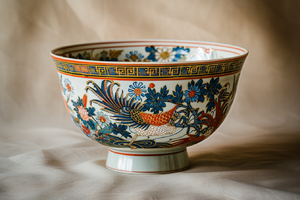Ko-Imari/zh-tw: Difference between revisions
From Global Knowledge Compendium of Traditional Crafts and Artisanal Techniques
Created page with "Ko-Imari 的獨特品質包括:" |
Created page with "小伊万裡瓷器並非僅供家庭使用。許多器物都經過特別定制,以迎合歐洲人的品味,例如大盤子、花瓶以及用於擺設的裝飾品。" |
||
| Line 21: | Line 21: | ||
*與後製更精緻的瓷器相比,瓷胎較厚。 | *與後製更精緻的瓷器相比,瓷胎較厚。 | ||
小伊万裡瓷器並非僅供家庭使用。許多器物都經過特別定制,以迎合歐洲人的品味,例如大盤子、花瓶以及用於擺設的裝飾品。 | |||
< | <span id="Export_and_European_Reception"></span> | ||
== | == 出口及歐洲接待 == | ||
17世紀至18世紀初,古伊万裡瓷器大量出口。它成為歐洲精英階層的時尚奢華。在歐洲各地的宮殿和貴族家中,古伊万裡瓷器裝飾著壁爐架、櫥櫃和桌子。歐洲瓷器製造商,尤其是邁森和尚蒂伊的製造商,開始生產受古伊万裡設計啟發的本土版本。 | |||
< | <span id="Evolution_and_Transition"></span> | ||
== | == 進化與轉變 == | ||
到了18世紀初,伊凡裡燒的風格開始演變。日本陶藝家發展出更精湛的技藝,並出現了諸如鍋島燒之類的新風格,注重優雅與內斂。如今,「古伊万裡」一詞被用來明確區分這些早期外銷的陶器與後來的國內或復興作品。 | |||
< | <span id="Legacy"></span> | ||
== | == 遺產 == | ||
小伊凡裡瓷器至今仍受到世界各地收藏家和博物館的高度重視。它被認為是日本早期對全球陶瓷貢獻的象徵,也是江戶時代工藝的傑作。小伊凡裡瓷器生動的設計和精湛的技巧持續激勵著傳統和當代的日本陶瓷藝術家。 | |||
< | <span id="Relationship_to_Imari_Ware"></span> | ||
== | == 與伊凡裡燒的關係 == | ||
雖然所有古伊万裡器都屬於伊万裡器這一大類,但並非所有伊万裡器都被視為古伊万裡器。兩者的差異主要在於年代、風格和用途。古伊万裡器特指最早的時期,其特點是充滿活力、出口導向和裝飾華麗的表面。 | |||
[[Category:Japan]] | [[Category:Japan]] | ||
[[Category:Japanese pottery]] | [[Category:Japanese pottery]] | ||
Latest revision as of 20:42, 17 July 2025
Ko-Imari

「古伊万裡」(字面意思是「古伊万裡」)指的是日本最早、最具代表性的伊凡裡瓷器風格,主要產於17世紀。這些瓷器產自有田町,並從附近的伊凡裡港出口,伊凡裡港也因此得名。古伊万裡瓷器以其充滿活力的裝飾風格及其在早期全球瓷器貿易中的歷史意義而聞名。
歷史背景
小伊凡裡瓷器興起於江戶時代初期,大約17世紀40年代,當時有田地區發現了瓷土。最初受到中國青花瓷的影響,日本本土陶藝家開始發展自己的風格。隨著明朝滅亡,中國瓷器出口量下降,日本瓷器開始填補國際市場的空白,尤其是透過與荷蘭東印度公司的貿易。
主要特點
Ko-Imari 的獨特品質包括:
- 圖案大膽多彩,通常將鈷藍色釉下彩與紅色、綠色和金色釉上彩相結合。
- 裝飾密集對稱,幾乎覆蓋整個表面,常被描述為富麗堂皇,甚至華麗。
- 圖案包括菊花、牡丹、鳳凰、龍以及風格化的波浪或雲朵。
- 與後製更精緻的瓷器相比,瓷胎較厚。
小伊万裡瓷器並非僅供家庭使用。許多器物都經過特別定制,以迎合歐洲人的品味,例如大盤子、花瓶以及用於擺設的裝飾品。
出口及歐洲接待
17世紀至18世紀初,古伊万裡瓷器大量出口。它成為歐洲精英階層的時尚奢華。在歐洲各地的宮殿和貴族家中,古伊万裡瓷器裝飾著壁爐架、櫥櫃和桌子。歐洲瓷器製造商,尤其是邁森和尚蒂伊的製造商,開始生產受古伊万裡設計啟發的本土版本。
進化與轉變
到了18世紀初,伊凡裡燒的風格開始演變。日本陶藝家發展出更精湛的技藝,並出現了諸如鍋島燒之類的新風格,注重優雅與內斂。如今,「古伊万裡」一詞被用來明確區分這些早期外銷的陶器與後來的國內或復興作品。
遺產
小伊凡裡瓷器至今仍受到世界各地收藏家和博物館的高度重視。它被認為是日本早期對全球陶瓷貢獻的象徵,也是江戶時代工藝的傑作。小伊凡裡瓷器生動的設計和精湛的技巧持續激勵著傳統和當代的日本陶瓷藝術家。
與伊凡裡燒的關係
雖然所有古伊万裡器都屬於伊万裡器這一大類,但並非所有伊万裡器都被視為古伊万裡器。兩者的差異主要在於年代、風格和用途。古伊万裡器特指最早的時期,其特點是充滿活力、出口導向和裝飾華麗的表面。
